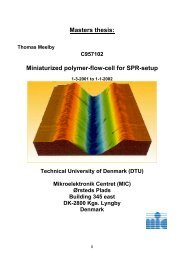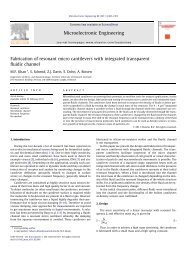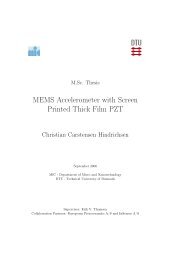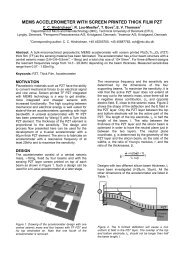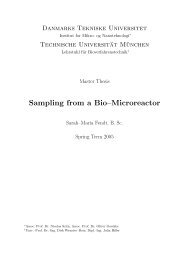Prototyping of microfluidic systems with integrated ... - DTU Nanotech
Prototyping of microfluidic systems with integrated ... - DTU Nanotech
Prototyping of microfluidic systems with integrated ... - DTU Nanotech
Create successful ePaper yourself
Turn your PDF publications into a flip-book with our unique Google optimized e-Paper software.
3.4 Cyclic Olefin Copolymer (COC)/Topas 29<br />
heat transition temperature usually lies some 5 – 10℃ below the glass<br />
transition temperature for a given material. The last two digits <strong>of</strong> the<br />
Topas grade number relate to the heat deflection temperature in the<br />
manner that the latter is approximately 10 times the two digits, meaning<br />
that Topas grade 5013 has a heat deflection temperature <strong>of</strong> 130℃.<br />
The viscosity number and the heat deflection temperature are (roughly)<br />
independent parameters. As stated above, Tg is changed by altering<br />
the norbonene content, while the viscosity – and thus the molecular<br />
weight – is changed in the polymerisation process, so that the average<br />
molecular length is altered.<br />
3.4.2 Optical properties<br />
Topas has a number <strong>of</strong> attractive optical features compared to PMMA,<br />
PC and PS. The birefringence is low, especially <strong>with</strong> high Tg grades,<br />
and it has a moderately high refractive index compared to the other<br />
polymers. The transparency is similar to that <strong>of</strong> PMMA and superior to<br />
PC and PS in the visible range. In the ultraviolet part <strong>of</strong> the spectrum,<br />
Topas is more transparent than the other polymers, as seen in Fig. 3.3.<br />
Transmission (%)<br />
100<br />
80<br />
60<br />
40<br />
20<br />
Quartz glass (Fused Silica)<br />
Topas ® 8007 X-10<br />
COC<br />
PS<br />
PC<br />
PMMA<br />
Quartz glass (Fused Silica)<br />
Glass (BK7)<br />
PMMA<br />
Glass (BK7)<br />
0<br />
180 200 220 240 260 280 300 320<br />
Wavelength (nm)<br />
340 360 380 400<br />
Figure 3.3: Ultraviolet transmission spectrum <strong>of</strong> Topas grade 8007 compared to<br />
PMMA, PC, PS and two glass types. At around 260 nm, Topas is still half transparent,<br />
contrary to the other polymer types, which are not transparent. Adapted from [33].<br />
PS<br />
PC



